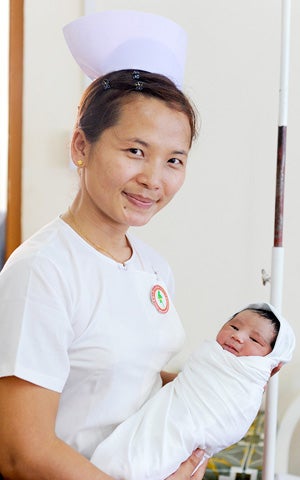As part of the Joint UN Health System Strengthening Initiative supported by the 3MDG Fund, UNFPA, with the leadership of the Ministry of Health and Sports, and with expertise from the Spanish research Institute, ICS Integrare, coordinated an assessment on the effective coverage of sexual, reproductive, maternal, newborn and adolescent health (SRMNAH) services in Myanmar. The assessment was undertaken from August 2015 to January 2016, and was supported by a national team of consultants. UNFPA commissioned the assessment to improve midwifery workforce planning and management in Myanmar. It was undertaken in accordance with the SRMNAH workforce assessment tool jointly developed by UNFPA, WHO and ICS Integrare.
The assessment looked in detail at four key areas which are at the core of the concept of effective coverage of sexual, reproductive, maternal, newborn and adolescent health (SRMNAH) services: availability, accessibility, acceptability and quality. The assessment found that the SRMNAH workforce in Myanmar is large enough to meet almost three quarters (73 per cent) of the need for essential SRMNAH interventions, assuming tasks are allocated to health workers efficiently.

However, considerable challenges relating to accessibility, acceptability and quality in Myanmar could mean that effective coverage of SRMNAH services is as low as 24 per cent nationally. There are considerable disparities between States/Regions, ranging from 48 per cent in Kayah to 9 per cent in Chin.
The findings were disseminated at a workshop on 27 September 2016, jointly conducted by the Department of Health Professional Resource Development and Management, and included participants from various health departments, UN agencies, NGOs, INGOs, the Myanmar Nurse and Midwife Association, Myanmar Nurse and Midwife Council, midwifery schools, and practicing midwives.
Three strategies were considered that could potentially increase the extent to which Myanmar’s health workforce better meets the SRMNAH needs of the entire population. All three strategies focus primarily on midwives, as they are the backbone of Myanmar’s SRMNAH system, and in a unique position to provide services across the full continuum of SRMNAH care.
The first of the three strategies involves task shifting: this would mean that all activities relating to disease control and environmental sanitation would be removed from the duties of midwives and would become the responsibility of public health supervisors. Midwives would then be able to spend more of their available working time on the SRMNAH services for which they are specifically trained.
The second strategy focuses on improving SRMNAH workers’ performance. This would include the provision of in-service training to all midwives in the four basic emergency obstetric and newborn care (BeMOC) essential medical interventions that they are authorized to perform, which treat the major causes of maternal and newborn morbidity and mortality, and training in modern methods of post-abortion care. In addition it was proposed that the infrastructure and working conditions of midwives, especially those deployed in hard-to-reach areas, should be improved.
The third strategy is to ensure that more competent graduates are part of the SRMNAH workforce. This could be achieved by: increasing the number of graduate midwives; introducing a bachelor’s degree course in midwifery with a curriculum that meets global standards for midwifery education as well as Myanmar’s specific needs; increasing midwives’ salaries to reflect their level of education; improving recruitment and retention of midwives in hard-to-reach areas; and improving the timely deployment of newly qualified midwives to the public health system.
These recommendations will form the basis for the development of evidence-based midwifery workforce policy and planning to improve the health system. The goal is to provide high quality sexual and reproductive health services for women, adolescents and newborns across the country, including in hard-to-reach and remote areas.

